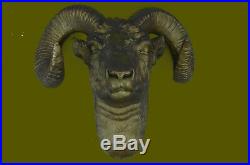
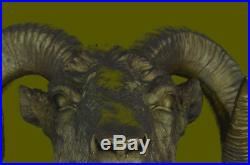
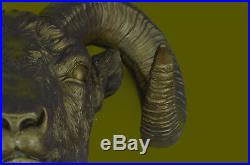
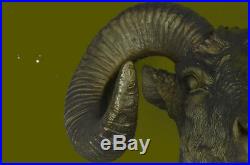
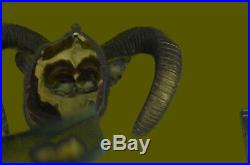
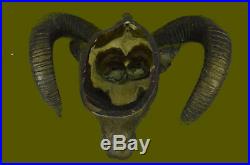
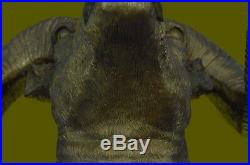
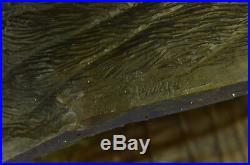

Collectible Detailed Extra Large Head with Antlers Chic and Trendy Bronze&#######xC2;&#######xA0. Collectible Detailed Extra Large Head with Antlers Chic and Trendy Bronze&#######xA0. &#######xA0;Condition: This sculpture is in perfect condition. Bronze Dimensions :Height&#######xA0;19″ x Width 19″ Weight : 28 LBS Inventory : 53X090431035 &#######xA0. This incredibly detailed wall piece will be the focus or wonderful addition to any country style area. The Ram’s defining features shine in this sculpture: a thick mane, prominent mouth and nose, and bulging eyes. The sculpture is reminiscent of the precious image of a Ram sticking its head out of the barn door waiting to be touched. This piece was crafted using the lost wax method. It is signed Barye. The Art of Lost Wax. Lost wax casting has been around for thousands of years, yet few people understand how the process actually works. &#######xA0; Although mechanization has facilitated the lost wax process of bronze casting, the procedure is basically the same as that used by the Chinese when they first developed the process in the 2nd millennium BC. First the artist creates an original sculpture out of any number of media, including stone, wax, clay, wood and pottery. &#######xA0; This image is coated with a silicone rubber molding material that makes two rubber mold halves (each rubber mold has a front and a back piece). A fiberglass outer shell is added to the back of each mold so it retains its shape and rigidity during subsequent uses. &#######xA0; These molds are the only components that are ever re-used in the casting process. All other components are re-created for each casting. Once the molds are done, the insides are coated with layers of wax. The halves are then bound together and wax poured inside to complete the wax image being created. &#######xA0; Once the wax has cooled, the mold is peeled away, yielding a wax image (the wax positive) duplicating the original sculpture. &#######xA0; This image must then be “touched -up” to remove any seam lines, scratches or other flaws, as well as to recreate any pattern or texturing that was lost or damaged when the wax was made. &#######xA0; The quality of the finished bronze relies on a clean, high quality mold and an impeccably recreated wax image that is as near to perfect as possible. The next step, “gating”, is the application of a series of tubes and funnels that allow the molten bronze to flow through to the bottom of the ceramic shell and the hot gases to escape at the same time. &#######xA0; These sprus are created by attaching wax rods to the finished wax form at strategically spaced locations. After the gating is completed each wax form is dipped in a liquid ceramic silica-sand compound so it is completely coated inside and out. Holes called “patches” have been cut into the wax to allow an entrance to the inside of the form. &#######xA0; The form is subsequently dipped 6 to 12 or more times over a period of several days until the desired shell thickness is achieved. Once these ceramic shells have dried thoroughly the pieces are placed into an autoclave and the wax is melted out (hence the term “lost wax”), to be reclaimed and used again. The shells are then cured in a kiln so they will withstand the temperature of the molten bronze being poured into them. Bronze ingots are melted to a temperature of approximately 2000&#######xB0;F and poured into the cured ceramic shells. &#######xA0; As the sculpture cools the ceramic shell begins to pop away from the bronze. &#######xA0; This shell will be completely broken away, using a hammer and chisel, before the superfluous metal materials are cut away. The casting is then sandblasted in preparation for metal finishing. &#######xA0; Any pieces of a sculpture that were cast separately are welded back onto the sculpture and any seam lines or other imperfections are removed or “chased”. Finally, any texturing that was lost or damaged in the casting or welding process is recreated. &#######xA0; The sculpture is then polished in preparation for application of the patina. The different colored finishes that are possible on cast bronze sculptures are called patina’s. &#######xA0; The various colors, patterns and textures obtained in the patina process are achieved through a combined application of chemicals and heat, augmented by hand stippling, or spraying with an air brush, and sealed with lacquer and waxes. Most bronzes are part of a “limited edition” containing a fixed number of castings. &#######xA0; This edition number is decided by the artist, usually after the first piece has been cast, and individually stamped on each piece i. 1/100 thus concluding the process of bronze sculpture production. Virgin Islands, however, an additional charge may be required. Custom Works Of Art Are Non-Refundable. We sell our bronze sculptures as reproductions, unless the title indicate it as original. See our other items. Collectible Detailed Extra Large Head with Antlers Chic and Trendy Bronze Description Condition: This sculpture is in perfect condition. Bronze Dimensions :Height 19″ x Width 19″ Weight : 28 LBS Inventory : 53X090431035 This incredibly detailed wall piece will be the focus or wonderful addition to any country style area. The Art of Lost Wax Lost wax casting has been around for thousands of years, yet few people understand how the process actually works. Although mechanization has facilitated the lost wax process of bronze casting, the procedure is basically the same as that used by the Chinese when they first developed the process in the 2nd millennium BC. The Rubber Mold First the artist creates an original sculpture out of any number of media, including stone, wax, clay, wood and pottery. This image is coated with a silicone rubber molding material that makes two rubber mold halves (each rubber mold has a front and a back piece). These molds are the only components that are ever re-used in the casting process. The Wax Positive Once the molds are done, the insides are coated with layers of wax. Once the wax has cooled, the mold is peeled away, yielding a wax image (the wax positive) duplicating the original sculpture. This image must then be “touched -up” to remove any seam lines, scratches or other flaws, as well as to recreate any pattern or texturing that was lost or damaged when the wax was made. The quality of the finished bronze relies on a clean, high quality mold and an impeccably recreated wax image that is as near to perfect as possible. Gating The next step, “gating”, is the application of a series of tubes and funnels that allow the molten bronze to flow through to the bottom of the ceramic shell and the hot gases to escape at the same time. These sprus are created by attaching wax rods to the finished wax form at strategically spaced locations. Ceramic Shell Casting After the gating is completed each wax form is dipped in a liquid ceramic silica-sand compound so it is completely coated inside and out. The form is subsequently dipped 6 to 12 or more times over a period of several days until the desired shell thickness is achieved. Lost Wax Once these ceramic shells have dried thoroughly the pieces are placed into an autoclave and the wax is melted out (hence the term “lost wax”), to be reclaimed and used again. The Pour Bronze ingots are melted to a temperature of approximately 2000°F and poured into the cured ceramic shells. As the sculpture cools the ceramic shell begins to pop away from the bronze. This shell will be completely broken away, using a hammer and chisel, before the superfluous metal materials are cut away. Sandblasting The casting is then sandblasted in preparation for metal finishing. Any pieces of a sculpture that were cast separately are welded back onto the sculpture and any seam lines or other imperfections are removed or “chased”. Texturing Finally, any texturing that was lost or damaged in the casting or welding process is recreated. The sculpture is then polished in preparation for application of the patina. Patinas The different colored finishes that are possible on cast bronze sculptures are called patina’s. The various colors, patterns and textures obtained in the patina process are achieved through a combined application of chemicals and heat, augmented by hand stippling, or spraying with an air brush, and sealed with lacquer and waxes. Limited Editions Most bronzes are part of a “limited edition” containing a fixed number of castings. This edition number is decided by the artist, usually after the first piece has been cast, and individually stamped on each piece i. Inkfrog terapeak inkFrog Analytics. The item “Rams Head Bust Bronze Sculpture For Wall Hand Made Statue Original Decor Art” is in sale since Saturday, September 10, 2016. This item is in the category “Art\Art Sculptures”. The seller is “europeanbronze” and is located in Mineola, New York. This item can be shipped worldwide.
- Original/Reproduction: Reproduction
- Listed By: Dealer or Reseller
- Medium: Bronze
- Subject: Animals
- Largest Dimension: 12in.-24in.
- Region of Origin: Europe
- Originality: Reproduction
- Artist: Barye

